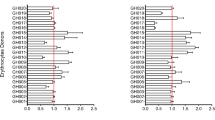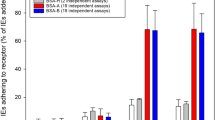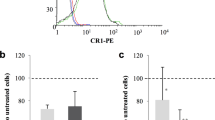Abstract
It has been suggested that one of the main factors which determines host susceptibility to different malarial parasites is the interaction of their invasive forms, merozoites, with specific receptors on the red cell membrane1–3. Thus the Duffy blood group determinants may be involved in the entry of Plasmodium vivax but not of Plasmodium falciparum into human red cells. When analysing red cells deficient in various blood group antigens, Miller et al. noted3 that two samples of En(a−) cells showed a reduction of invasion by P. falciparum4. These cells lack both the major transmembrane sialoglycoprotein, glycophorin A (or MN glycoprotein), and the independently segregating Wrightb (Wrb) antigen and also show increased glycosylation of band 3, the major membrane-penetrating glycoprotein. Despite this, En(a−) individuals are haematologically normal5. We have now confirmed that En(a−) cells obtained fresh from three En(a−) individuals are indeed relatively resistant to invasion by P. falciparum although they are able to support parasite development. Our results also indicate that these cells may be a useful model in the search for a putative receptor for P. falciparum.
This is a preview of subscription content, access via your institution
Access options
Subscribe to this journal
Receive 51 print issues and online access
$199.00 per year
only $3.90 per issue
Buy this article
- Purchase on Springer Link
- Instant access to full article PDF
Prices may be subject to local taxes which are calculated during checkout
Similar content being viewed by others
References
McGhee, R. B. Ann. N.Y. Acad. Sci. 56, 1070–1073 (1953).
Butcher, G. A., Mitchell, G. H. & Cohen, S. Nature 244, 40–42 (1973).
Miller, L. H., Dvorak, J., Shiroishi, T. & Durocher, J. J. exp. Med. 138, 1597–1601 (1973).
Miller, L. H. et al. J. exp. Med. 146, 277–281 (1977).
Anstee, D. J. Sem. Hemat. 18, 13–31 (1981).
Trager, W. & Jensen, J. B. Science 193, 673–675 (1976).
Haynes, J. D., Diggs, C. L., Hones, F. A. & Desjardins, R. E. Nature 263, 767–769 (1976).
Phillips, R. S., Trigg, P. I., Scott-Finnigan, T. J. & Bartholomew, R. K. Parasitology 65, 525–535 (1972).
Darnborough, J., Dunsford, I. & Wallace, J. A. Vox. Sang. 17, 241–255 (1969).
Furuhjelm, U. et al. Vox. Sang. 17, 256–278 (1969).
Taliano, V. et al. Vox. Sang. 38, 87–93 (1980).
Kleihauer, E., Braun, H. & Betke, K. Klin. Wochenschr. 35, 637–638 (1957).
Diggs, C. L. et al. J. Parasit. 57, 187–188 (1971).
Metaxas, M. N. & Metaxas-Buehler, M. in Human Blood Groups 344–352 (Karger, Basel, 1976).
Furthmayr, H. Nature 271, 519–524 (1978).
Miller, L. H., Aikawa, M. & Dvorak, J. A. J. Immun. 114, 1237–1242 (1975).
Wasniowska, K., Drzeniek, Z. & Lisowska, E. Biochem. biophys. Res. Commun. 76, 385–390 (1977).
Steck, T. L. J. Cell Biol. 62, 1–19 (1974).
Pasvol, G., Weatherall, D. J. & Wilson, R. J. M. Br. J. Haemat. 45, 285–295 (1980).
Lambros, C. & Vanderberg, J. P. J. Parasit. 65, 418–420 (1979).
Pasvol, G., Wilson, R. J. M., Smalley, M. E. & Brown, J. Ann. trop. med. Parasit. 72, 87–88 (1978).
Wilson, R. J. M. & Phillips, R. S. Nature 263, 132–134 (1976).
Perkins, M. J. Cell Biol. 90, 563–567 (1981).
Author information
Authors and Affiliations
Rights and permissions
About this article
Cite this article
Pasvol, G., Wainscoat, J. & Weatherall, D. Erythrocytes deficient in glycophorin resist invasion by the malarial parasite Plasmodium falciparum. Nature 297, 64–66 (1982). https://doi.org/10.1038/297064a0
Received:
Accepted:
Issue Date:
DOI: https://doi.org/10.1038/297064a0
This article is cited by
-
Modelling pathogen load dynamics to elucidate mechanistic determinants of host–Plasmodium falciparum interactions
Nature Microbiology (2019)
-
Complex signatures of natural selection at GYPA
Human Genetics (2018)
-
Biorheological Action of Ascaris lumbricoides Larvae on Human Erythrocytes
Cell Biochemistry and Biophysics (2013)
-
The molecular genetics of blood group polymorphism
Human Genetics (2009)
-
The genotypes of GYPA and GYPB carrying the MNSs antigens are not associated with cerebral malaria
Journal of Human Genetics (2007)
Comments
By submitting a comment you agree to abide by our Terms and Community Guidelines. If you find something abusive or that does not comply with our terms or guidelines please flag it as inappropriate.



